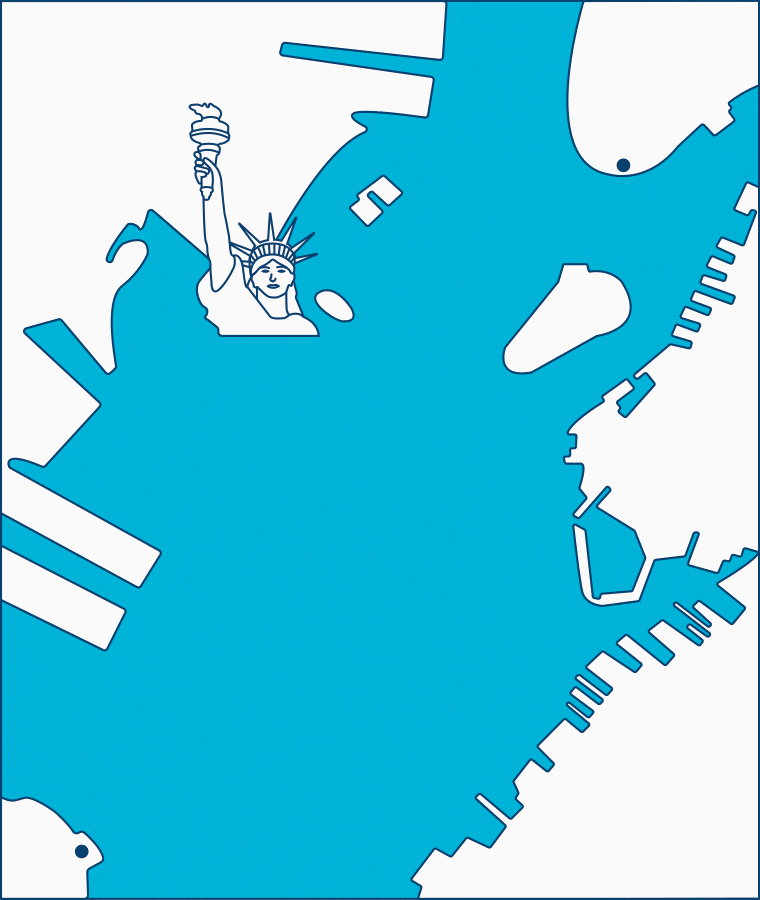 Customer
Customer
New York City Department of Transportation (NYC DOT)
The Staten Island Ferry, which has been plying back and forth between Manhattan and Staten Island since 1905, is operated by the NYC DOT, whose decision to opt for the Voith Schneider Propeller (VSP) demonstrates their total commitment to providing a reliable and safe ferry service.
 The benefit
The benefit
25 million passengers reliably transported every year
Every year some 25 million passengers in New York rely on the Staten Island Ferry to take them to their destinations in a reliable and convenient manner. The VSP ensures they arrive safe and sound.
 Product
Product
Voith Schneider Propeller (VSP)
The VSP is a combined propulsion and control system in one, capable of generating thrust in any direction thanks to its special design. Short response times to control commands also facilitate rapid, safe and precise maneuvering in adverse conditions. The VSPs make mooring and casting off both smooth and efficient.
 The application
The application
Staten Island Ollis-class ferry
A total of three of the new Ollis-class ferries are due for completion by 2022 and will be fitted with Voith's largest VSP type. Four fill-controlled turbo couplings in each vessel facilitate a smooth drivetrain startup while distributing the load between two propulsion units per VSP and minimizing vibrations. Voith's electronic control system enables the captains to steer the ships safely.
Full thrust, full safety.
A new generation of ferries was launched in 2021 for the iconic route between Manhattan and Staten Island. The reliability and safety of the propulsion and control systems has been optimized by the Voith Schneider Propeller (VSP).
High-performance, double-ended ferries – capable of carrying up to 4,500 passengers per crossing – ply back and forth between terminals in the New York boroughs of Manhattan and Staten Island on a daily basis. Over 25 million people a year depend on this iconic service.
Any kind of failure or outage on one of these ferries has a massive impact on New York’s already heavily congested traffic system, but these can be effectively prevented with the aid of the VSP.
A new generation of ferries has been operating safely and reliably in New York's Upper Bay since the early fall of 2021, which is due in no small part to the VSPs installed in the new Ollis-class ships. This combined propulsion and control system was selected ahead of all other systems following extensive comparative studies and pilot projects. The VSP’s optimal maneuverability prove to be completely convincing, even when currents, waves and ice make for difficult conditions.




The new VSP-powered ferry also grabbed the limelight at the WorkBoat shipbuilding trade show in New Orleans, where it won the distinction of "Boat of the Year 2021" – a sort of "Oscar for ships".
Why not increase the reliability and safety of your own ferry services?
Reap the benefits of our propulsion system, which can be operated efficiently and safely with all environmentally friendly drive systems.
The core benefits of the Voith Schneider Propeller at a glance:
- The ability to react quickly to changing traffic situations
- Optimum maneuverability, even under extreme current and weather conditions
- Low-vibration operation in conjunction with Voith turbo couplings
- Compliant with current noise emission standards
- Minimal vibrations, comfortable operation
- Smooth mooring and casting off for optimum passenger safety
- State-of-the-art gas engines for reduced emissions
The iconic Staten Island Ferry – facts and figures:

A propulsion system that has been winning hearts and minds for almost 100 years.
You, too, can increase the efficiency and reliability of your own ferry fleet. We’d be glad to explain all the benefits of our extremely durable VSP, which can also be combined with our turbo coupling systems.




